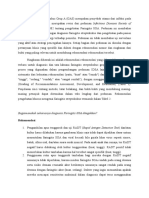
1076 Rater Reliability of Fahn's Tremor Rating Scale in Patients With Multiple Sclerosis. The aim of this study was to determine the reliability of Fahn's Tremor Rating Scale. Fahn S, Tolosa E, Marin C. Components of the Fahn-Tolosa-Marin clinical tremor rating scale were assessed pre- and postoperatively. Visual analog scale scores for overall.
Methods The large and small spirals of FTM were drawn with each hand on two consecutive days by 14 men and four women (age 60±8.7 years [mean±SD]) with mild to severe essential tremor. The drawings were simultaneously digitized with a digitizing tablet. Tremor in each digitized drawing was computed with spectral analysis in an independent laboratory, blinded to the clinical ratings. The mean peak-to-peak tremor displacement (cm) in the four spirals and mean FTM ratings were compared statistically.
Methods Twenty patients were enrolled in an unpublished open-label pharmacokinetic–pharmacodynamic study of sodium oxybate for the treatment of essential tremor, conducted by Jazz Pharmaceuticals. Details of the study design can be found on ClinicalTrials.gov (All patients participated after giving their informed written consent, approved by a local human subjects committee. The patients stopped all drugs for tremor at least five half-lives before the study. They also abstained from alcohol and caffeine for 48 hours. Fourteen men and four women (age 60±8.7 years [mean±SD]) with mild to severe essential tremor completed the study in which placebo or sodium oxybate was administered orally at 8 a.m. On three consecutive days.
Baseline assessments of tremor were performed each day between 7 and 8 a.m. Tremor was quantified with the FTM rating scale and a digitizing tablet.
All patients were examined by the same neurologist (A.L.E.). The paper with the large and small FTM spiral templates was mounted on a Wacom Intuos 3 digitizing tablet so that the same drawings were rated and digitized. Tremor amplitude in each digitized drawing was computed in an independent central laboratory using spectral analysis. The software used is available online. The technician performing the tablet analyses was blinded to the tremor ratings and study design.
The grand average of mean peak-to-peak tremor displacement (cm) in the four spirals (large and small spirals drawn with each hand) was compared with the grand average of the four FTM spiral ratings. A paired t test analysis of the baseline FTM spiral ratings and tablet measures on days 1 and 2 revealed a statistically significant practice effect or carryover effect from day 1 to day 2. The mean FTM spiral rating decreased slightly (1.21 to 0.88, t=–3.011, p=0.008), as did the log-transformed tablet measure (geometric mean 0.28 to 0.20, t=–2.431, p=0.026).
By contrast, the baseline FTM and tablet means were statistically identical on days 2 and 3 (mean FTM spiral ratings, 0.88 and 0.94, t=0.719, p=0.48; geometric mean tablet measures, 0.20 to 0.19, t=–0.457, p=0.65). We therefore used the data from days 2 and 3 in this study to estimate test–retest reliability and MDC. In this, study, baseline 1 refers to the baseline data from study day 2, and baseline 2 refers to the data from study day 3. Baseline assessments from these two days were used to compute test–retest reliability (two-way random single measures intraclass correlations [ICCs], absolute agreement) and minimum detectable change (MDC) for the FTM spiral ratings and digitizing tablet measurements.
MDC was computed using the formula MDC=SDd1.96, where SDd is the standard deviation of the differences for the two measurements. For the grand average of the four FTM spiral ratings, MDC was expressed as a percentage of the baseline 1 mean (MDC%). The tablet data were positively skewed, so log 10 transformation was performed to normalize these data. Note that SDd of log-transformed data is a ratio, and the MDC is therefore also a ratio; they are not log SDd and log MDC of the non-transformed data. MDC% of the log-transformed data is expressed as a percentage of the baseline geometric mean, using the equation MDC%=(1−10 −MDC)100. Aomei rusifikator one. All statistical analyses were performed with MedCalc ® statistical software ().
Results The mean spiral ratings did not differ statistically from a normal distribution (D’Agostino–Pearson test: p=0.16 for baseline 1 data and p=0.13 for baseline 2 data). The tablet data were positively skewed and deviated significantly from a normal distribution (D’Agostino–Pearson test: p. Discussion This is the first blinded study demonstrating a strong correlation between tablet and FTM spiral ratings, and this study provides much-needed estimates of test-retest reliability and MDC% for tablet and FTM spiral ratings.